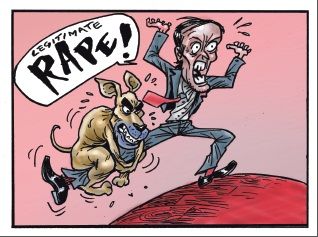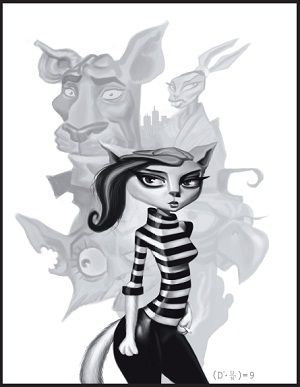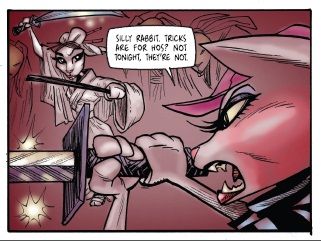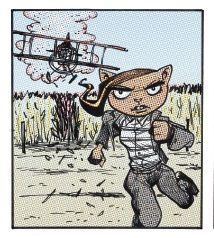Contropussy, written by Emma Caulfield (Buffy’s own Anya) and Camilla Outzen Rantsen and with art by Christian Meesey, is a very weird and incredibly exciting read. Contropussy follows the life of a cat: a housecat called Sonnet by day and a femme fatale by the name of Contropussy at night. Make no mistake, Contropussy is a contemporary embodiment of the attitude of exploitation films and underground comix of the ‘60s and 70s. Double O, a dog and the main love interest of Contropussy, appears exactly like Booga, TG’s Kangaroo love interest, in the exploitation-style comic Tank Girl, and this homage brings to the forefront the controversy surrounding sexuality and sexual partners inherent in both comics. Because if Contropussy is sending any sort of political message, it’s about who can do what with their sexuality, nay-sayers be damned.
Contropussy is brazen in its talk of sexuality, as the first introduction to the titular heroine involves her monologue about masturbation, having a one-night stand with a stray cat, and reminiscing about her break up with her partner, Double O. True to any spy-thriller, the story itself focuses on Contropussy’s own adventures and mishaps, involving rescuing her friend from a cat brothel, international abductions, mind-control and the excitement and dangers of falling in love. Contropussy pushes the limits, in an often slightly-uncomfortable, maybe-don’t-read-this-book-in-a-café kinda way. While it does hold back on explicit depictions of sex, it makes no qualms about what Contropussy gets up to (or who she gets down with) on her late night prowls.
While Contropussy is very true to form in imitating the comix style of an unapologetic “what can I get away with?” mindstate it is taking place in 2013 and not 1970, and the cultural implications of the gender dynamics and overt sexuality are at the forefront. Indeed, in Alternative Comics: An Emerging Literature Charlies Hatfield describes Robert Crumb's "originality [as laying] in his use of such figures to express a vision at once self-regarding, almost solipsistic, yet socially aware, satirical, even politically astute." Comix, in their refusal to be censored or limited, create the perfect avenue for political play.
While Contropussy can absolutely be enjoyed for the animal-centric sexploitation romp it is, it is also hitting at some poignant issues surrounding the depiction of female sexuality. There is no escaping the reverberations of inverting and playing with typical gender dynamics, especially when using the James Bond spy-thriller genre as a framing device. This is where the exploitation element comes in: Caulfield and Rantsen show Contropussy getting down and dirty constantly, consistently and unapologetically.
The punning name “Contropussy” is a clear homage to th
e most famous Bond Girl names, such as Pussygalore and Octopussy. She is the hero of this tale, oozing sex appeal and commanding respect, while Double O is relegated to the position of a (fairly one-note) sex object. Sadly, the Double O character doesn’t receive any in-depth characterization to flesh out this parody: throughout the narrative he remains the sex object, love interest and sometimes ally/sidekick for Contropussy. Despite this, towards the end of the graphic novel, Double O does provide one of the best laugh-out-loud situations when he attacks Todd Akin, who is spouting his infamous “legitimate rape” line, ultimately aligning Double O on the feminist side of the female sexuality debate. This isn’t a question of what men can do with their sexuality, because they haven’t faced the same shaming as women have. We admire James Bond, and slut-shame the Bond Girls. What Contropussy is wrangling with is inverting this to give the same level of respect to the feline and feminine version of Bond. It’s exploitation at its finest: show Contropussy doing what Bond does, unabashedly and rather awesomely.
In exploitation genres, the brazenness that Contropussy embodies is what works. For example, in the 1970’s exploitation movie TNT Jackson there is a great scene where the villain attempts to intimidate and torture TNT by threatening to burn her exposed breasts with a cigarette. The fact that the villain violently rips off her blouse shows this act is supposed to give him the power over her via controlling/threatening her sexuality. What follows is TNT handily defeating all the henchmen, wearing only panties. This scene is great and works so well in the exploitation genre because it shows TNT taking back the power that was being lorded over her: now she’s showing that she can take these goons on despite being stripped, robbing the attempt of using her sexuality against h
er of any of its power. You get both: exposed breasts for titillation, but also a scene latent with a feminist backbone.
Contropussy achieves this same effect throughout the narrative. Caulfield offers Contropussy, a very sexualized character, who makes references and jokes about her preference for certain types of bondage, as a way to illustrate that sexual liberation is entirely different from sexual exploitation. Early on in the graphic novel, Contropussy saves her friends from a cat brothel (by defeating her arch-nemesis Evil Rabbit in a grindhouse-level-of-gross/in-your-face-kung-fu battle), showing that there is a difference between embodying sexuality and having that sexuality controlled, used and exploited (as further cemented through Double O's attacking of Todd Akin for his "legitimate rape" comments). Contropussy is very smart and works the exploitation/homage to the comix scene incredibly well. Caulfield and Rantsen lets Contropussy run rampant, showing that overt sexuality isn’t shameful.
Beyond just the exploitation-style politics, Contropussy reads like an old-school film noir (another beloved genre the narrative is paying homage to while simultaneously inverting). For example, Contropussy describes a character who “
walks across the street like a slow, slow drag off a cigarette after a really long day.” Contropussy parodies typical spy-thrillers like Hitchcock’s North by Northwest, offering a narrative that shifts the power from women in spy-thrillers as just fetishized sex object to the sexy main protagonist. By inverting typical dynamics found in spy genres, and by using the exploitation style of the underground comix scene, Contropussy is designed to shock and delight. And if the name itself isn't a giveaway, there are plenty of shocks and boundaries being pushed. The use of animals works on an allergorical level, illustrating tensions found in the sexual relationships being exhibited, but it also provides shocks and laughs on a basic, literal level.
The stylized art is pitch-perfect for all of the intents of the narrative. Both realistic and exaggerated, Meesey's art evokes the glamour of thriller movies, while presenting raw, unapologetic visuals at home in comix. Rather than offering a structured narrative that centres around one achievable goal, Contropussy reads episodically, due to its origins as webcomic, where we get scenes and stories that are bound together through the reader’s devotion to the characters, rather than a defining storyline. But this works, because it’s not necessarily the story that matters, but how Caulfield and Rantsen are inverting typical gender dynamics and paying homage to the genres that have paved the way for anti-censorship in comics and films.
Sections of this post originally appeared on NerdSpan by Kaitlin Tremblay.




